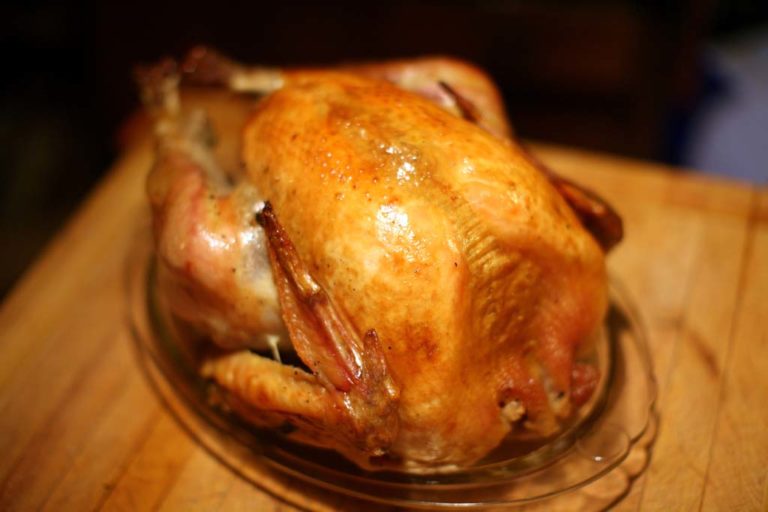
Chef's notes:
My family, like most, roast turkeys for all of the major holidays: Thanksgiving, Christmas, and Easter, and sometimes just for fun. On a recent trip home, my mom surprised me with a thawed turkey. It was June. But I love turkey dinner, so I was more than happy to roast it for dinner. We called it Thanksgiving in June. It was one of the best turkeys that I have roasted to date (find whole turkeys here). It tasted amazing, and it looked even better.
There are several reasons why I believe this turkey recipe turned out so well. First of all, I used simple seasonings: fresh thyme, onion, sea salt, and black pepper. Secondly, I used a heavy iron roasting pan with a lid. Lastly, I used a time-tested and proven roasting method. For more details continue reading below.
Ingredients
- 1 whole turkey
- Thyme
- Onions
- Sea salt
- Black pepper
Roast Turkey Recipe: Whole Turkey Sea Salted and Roasted in a Cast Iron Pan with Fresh Thyme and Sliced Onions
- Thaw a turkey and remove the giblets. It will take three days for a turkey to thaw in the fridge. If you want to thaw it faster, submerge it in cool running water. It will thaw in a few hours that way. Make sure you use cool running water, as hot water will make you sick. Once thawed, remove the giblets from the neck or chest cavity. Don’t throw the giblets away; use them to make gravy. For more information on making great gravy, read the section at the bottom.
- Prepare the turkey for roasting. Preheat the oven to 425 F, and move the oven racks to make room for the roasting pan and turkey. Season the turkey inside and out with salt and pepper, and try to get it under the skin too. Rub the turkey with vegetable oil until you have a thin layer of it; this will help to make it golden brown. Inside the cavity place a handful of fresh thyme. In the bottom of the put 2 onions sliced up. Use a piece of twine to tie the legs together. Put the turkey in the roasting pan on top of the onions.
- Roast the turkey uncovered at 425 degrees F for 25 minutes. Place the roasting pan into the oven, making sure the turkey is not too close to the top of the oven, as it will burn. Try to get it as low as you can. Close the door to the oven, and set a timer for 15 minutes. Check the turkey and rotate the pan to promote even cooking. If the turkey is getting too dark, turn the oven down to 400 degrees. Let it roast for another 10 minutes. Then remove it to a hot pad.
- Cover the turkey and roast at 350 degrees F until it's done. For this last stage of turkey roasting, it’s nice to have a heavy roasting pan with a tight-fitting lid. But if you don’t have one, then use a couple layers of aluminum foil instead. Just try to keep the foil from coming into contact with the turkey. Roast the turkey at 350 degrees F until a digital thermometer reads a temperature of 165 degrees F. Let the turkey rest, covered, for 45 minutes before cutting into it. This should give you time to finish up the gravy.
Tips & Tricks
- Don’t put too much “stuff” in the cavity.
- You want some air to get in there so the inside of the turkey can cook too.
- If you don’t have any twine, use a piece of wire to tie the legs together.
- Don’t open the oven while the turkey is roasting.
- Turkey bones will make great stock, so don’t throw the scraps away.
- Don’t baste the turkey. Basting is for chumps.
- If you want the turkey to glisten when you bring it out, brush it with a little oil.
How to Make Homemade Turkey Gravy.
- Fry the giblets in a little butter until they are nice and brown.
- Remove the liver and set aside for later.
- Add enough water to the pan to cover the giblets by a couple inches.
- Simmer for 2‒3 hours on very low heat.
- Add a couple chunks of celery, onion, carrot, or bay leaf, if you have it on hand.
- After 2 or 3 hours, drain the broth and set aside.
- Once the turkey is done roasting, remove it from the pan and put the roasting pan on the stovetop over high heat.
- Add the broth to the pan, and scrape up the drippings.
- Set the roasting pan aside.
- Melt 4 Tbsp of butter in a frying pan.
- Combine with 4 Tbsp of flour to make a roux.
- Strain the drippings and add them to the pan.
- Stir in the roux and simmer until thickened.
- You may need more roux depending on how much broth you made.
- Adjust the salt and pepper.
- At this point, I mince up the liver and add it to the gravy. It’s optional but delicious.
